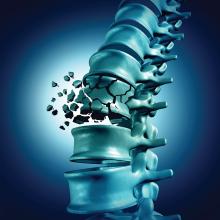Long-term tumor necrosis factor inhibitor therapy improved bone mineral density but did not reduce vertebral fractures or radiographic progression in patients with ankylosing spondylitis, according to results from a prospective cohort study.
The study, published in the Journal of Bone and Mineral Research, not only confirms previous reports showing an improvement of the bone mineral density (BMD) during tumor necrosis factor inhibitor (TNFi) treatment in patients with ankylosing spondylitis but also an increase in the number and severity of vertebral fractures despite TNFi treatment.
K.J. Beek, of the Amsterdam Rheumatology and Immunology Centre in Amsterdam, and colleagues followed 135 patients with ankylosing spondylitis from the Amsterdam Spondyloarthritis cohort who were started on TNFi therapy after treatment failure of a minimum of two NSAIDs. Only study participants who were naive to TNFi therapy were enrolled in the study. The patients had a mean disease duration of nearly 12 years; 70% were men.
After 4 years of anti-TNF therapy, the proportion of patients with a low BMD of the hip on dual-energy x-ray absorptiometry significantly decreased from 40.1% to 31.8% (P = .03) and at the lumbar spine from 40.2% to 25.3% (P less than .001), respectively.
In addition, outcomes related to vertebral fractures, including incidence, prevalence, and severity, did not improve following 4 years of anti-TNF therapy. Vertebral fracture prevalence increased from 11.1% with at least one fracture to 19.3% with at least one fracture at the 4-year follow-up. Most of the vertebral fractures occurred in the thoracic rather than lumbar spine.
Radiographic progression significantly increased over the course of treatment, based on a rise in median modified Stoke Ankylosing Spondylitis Spinal Score from 4.0 at baseline to 6.5 at 4-year follow-up. Patients with vertebral fractures had significantly worse radiographic progression.
“These findings show a contradiction, with improvement of bone mineral density on the one hand but a worsening of the bone processes on the other hand, indicated by the increase of fractures and radiographic progression,” the investigators wrote.
They acknowledged a key limitation of the study was the observational design, which did not include a matched control group.
“A recommendation for future studies would be to replicate our results in larger groups of ankylosing spondylitis patients,” they concluded.
No information on study funding or disclosures was available.
SOURCE: Beek KJ et al. J Bone Miner Res. 2019 Jan 28. doi: 10.1002/jbmr.3684.


